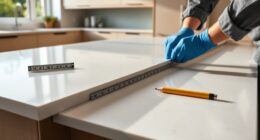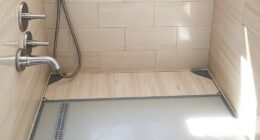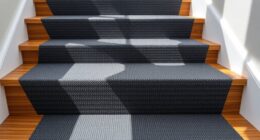To prepare for winter, focus on upgrading your windows with energy-efficient options like double or triple glazing, which boost insulation and cut energy costs. Inspect your current windows for gaps, drafts, or damage, and seal or replace them as needed. Adding window treatments like heavy curtains or films can also improve warmth. Timing is key—choose mild, stable weather for installation to ensure quality. Learn more tips to maximize comfort and savings before the cold months arrive.
Key Takeaways
- Schedule window upgrades during mild, stable weather in spring or early fall to ensure proper installation before winter.
- Choose energy-efficient window styles with double or triple glazing and low-e coatings for maximum insulation.
- Inspect and repair existing window frames and sealant to prevent drafts and improve insulation effectiveness.
- Use weatherproofing measures such as weatherstripping, curtains, or window films to enhance insulation and reduce heat loss.
- Prioritize high-quality windows from reputable brands to ensure durability, better insulation, and long-term energy savings.
Assessing Your Current Window Efficiency

Before considering new window upgrades, you need to understand how well your current windows are performing. Start by inspecting your window frames, looking for gaps, cracks, or warping that could let in drafts. Check the insulation materials around the frames; poor insulation can cause heat loss and increase energy bills. Feel for cold spots or air leaks when near the windows, especially during colder days. If your windows are old or drafty, their efficiency is likely compromised. Consider whether your current setup includes double-pane glass or if the seals have degraded. By evaluating these aspects, you’ll identify whether your windows need repairs, better insulation, or replacement to improve energy efficiency before winter hits. Additionally, understanding the value of home security systems can help you consider the security of your upgrades against potential vulnerabilities.
Choosing the Right Energy-Efficient Window Options
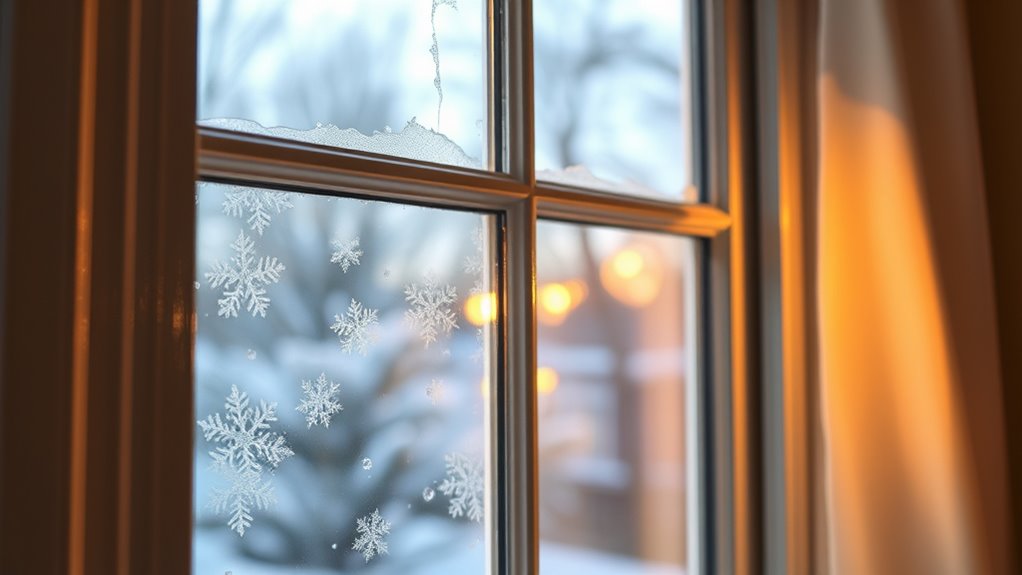
Once you’ve assessed the condition of your current windows, the next step is selecting the best energy-efficient options for your home. Consider window frame styles that best suit your aesthetic and insulation needs, such as vinyl, fiberglass, or wood. These materials vary in durability and thermal performance. Glass tinting is another effective upgrade, reducing heat transfer and glare while maintaining natural light. When choosing, think about your climate and how much sunlight your home receives. Here’s a quick guide:
| Window Frame Style | Suitable Climate | Key Benefits |
|---|---|---|
| Vinyl | Cold & Hot | Low maintenance, good insulation |
| Wood | Cold | Natural look, strong insulation |
| Fiberglass | All climates | Durable, energy-efficient |
| Aluminum | Mild climates | Affordable, lightweight |
| Composite | Variable | Combines benefits of others |
Selecting the right options enhances comfort and saves energy. Incorporating energy-efficient windows can also contribute to a sustainable living environment, promoting both cost savings and environmental responsibility.
Benefits of Double and Triple Glazing

Double and triple glazing considerably improve your home’s energy efficiency by providing extra layers of insulation, which help keep heat inside during winter and outside during summer. The benefits depend on the choice of window frame materials, such as uPVC, wood, or aluminum, which influence insulation performance. Additionally, modern glass coatings, like low-emissivity (low-e) layers, further enhance energy savings by reflecting heat while still allowing natural light. These coatings, combined with multiple panes, reduce heat transfer and prevent drafts. The increased insulation not only lowers your heating and cooling costs but also improves indoor comfort. Using self-watering plant pots as an analogy, well-insulated windows help maintain consistent indoor temperatures much like self-watering systems ensure plants receive steady moisture. Overall, upgrading to double or triple glazed windows with suitable frame materials and advanced glass coatings offers a practical way to make your home more energy-efficient before winter.
Installing Window Treatments for Added Insulation
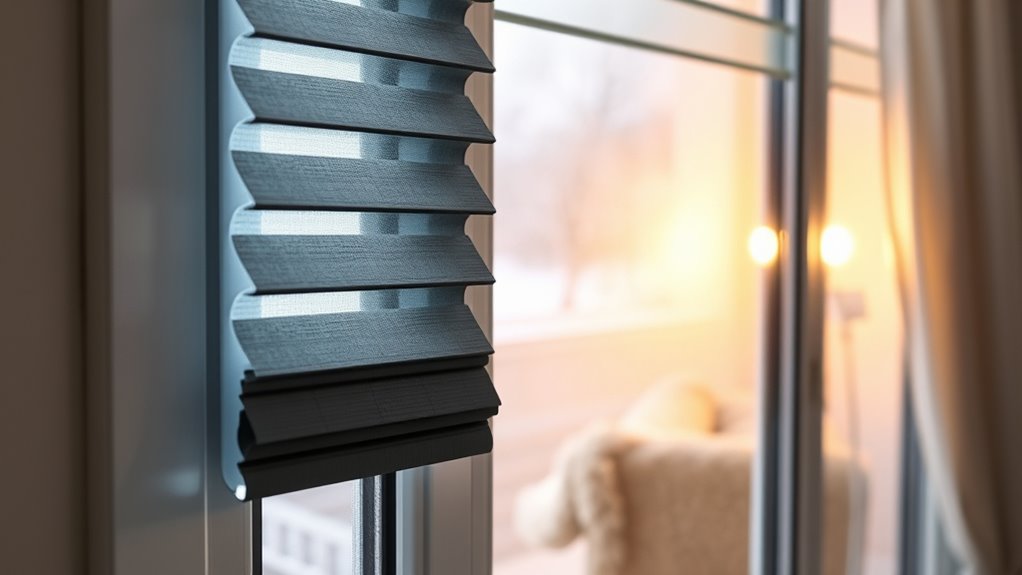
Installing window treatments such as curtains, blinds, or shades can considerably boost your home’s insulation by adding an extra barrier against heat loss or gain. Choosing the right drapery styles, like thick curtains or layered window coverings, enhances insulation during colder months. Heavy fabrics or insulated curtains trap air and block drafts, keeping warmth inside. For a more modern approach, consider window film, which reflects heat back into the room while reducing drafts. Combining drapery styles with window film provides an effective, multi-layered defense against energy loss. Additionally, selecting appropriate window treatments tailored for energy efficiency can maximize your home’s insulation. These treatments are easy to install and can be customized to match your décor, making your home more comfortable and energy-efficient before winter hits.
Proper Maintenance and Weatherproofing Techniques
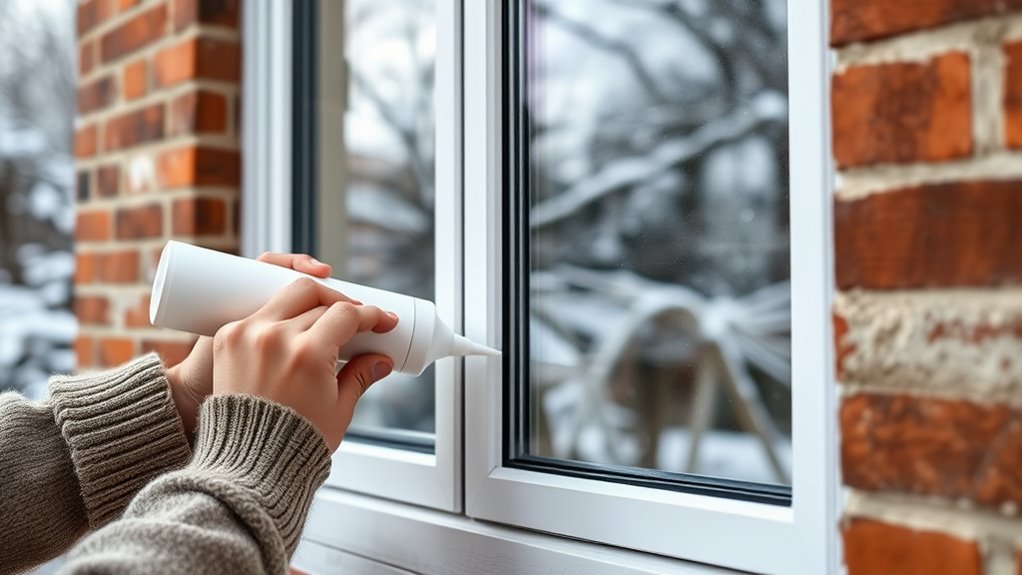
Regular maintenance and weatherproofing are essential to keep your windows performing efficiently year-round. Start by inspecting your window frame for cracks, rot, or damage, and repair as needed. Ensure the sealant application around the frame is intact; if you notice gaps or deterioration, reseal promptly. Clean your windows regularly to prevent grime buildup that can hinder proper sealing. Check for drafts by feeling around the edges on windy days and address leaks immediately. Additionally, consider applying weatherstripping to improve insulation. Properly maintained windows reduce energy loss and enhance comfort. Remember, consistent upkeep is key to extending your window’s lifespan and maximizing energy savings. Incorporating ergonomic design principles into your window and door choices can further improve energy efficiency and comfort. Keep these steps in mind as part of your winter preparation routine.
Timing Your Upgrade for Optimal Winter Performance

Choosing the right time to upgrade your windows can optimize winter energy savings and comfort. Typically, installing during mild weather or the off-season guarantees better results and fewer delays. Keep an eye on weather conditions to prevent installing during extreme cold or storms, which can impact the quality of your upgrade.
Ideal Installation Seasons
Timing your window upgrade is essential to guarantee you get the best performance during winter. The ideal installation seasons are typically spring and early fall when weather is mild, preventing delays caused by extreme cold or heat. Installing during these times allows your contractors to focus on proper sealing and storm proofing strategies without rushing. Additionally, moderate temperatures help ensure the durability of window frame materials like vinyl or wood, which can be sensitive to temperature fluctuations. Proper layering textiles and strategic lighting can further enhance your home’s insulation during colder months. Avoid summer or deep winter installations, as extreme conditions can compromise installation quality and increase energy costs. Planning ahead ensures your new windows are fully functional before the cold hits, maximizing energy savings and comfort. Keep these factors in mind for a seamless upgrade that prepares you for winter.
Pre-Winter Energy Savings
To maximize your energy savings before winter, scheduling your window upgrade at the right time is essential. Timing your installation guarantees you benefit from improved insulation and reduced heating costs during the cold months. Consider window frame materials like vinyl or fiberglass, which provide better insulation, and opt for glass coatings such as low-E to reflect heat inward. Here’s a quick guide:
| Material Type | Ideal Coating | Benefits |
|---|---|---|
| Vinyl | Low-E | Cost-effective, durable |
| Fiberglass | Reflective | Superior insulation |
| Wood | Tinted | Aesthetic appeal, energy-efficient |
| Aluminum | No coating | Less insulation, less ideal |
Planning ahead guarantees your upgrade is timely and effective. Additionally, paying attention to insulation properties can further enhance your windows’ performance and maximize energy savings during winter.
Weather Conditions to Watch
Monitoring weather conditions is crucial when planning your window upgrade for winter. Keep an eye on frost alerts to guarantee temperatures aren’t too cold for installation, which can cause materials to become brittle or adhesives to fail. Watch for wind gusts, as strong winds can make outdoor work unsafe and hinder installation accuracy. Ideal conditions include mild, stable weather with little to no frost and calm winds. Consider these factors before scheduling:
- No frost alerts in the forecast
- Wind gusts below 15 mph
- Temperature above freezing
- Clear, dry days
- Consistent weather patterns
Ensuring your chosen windows are compatible with popular brands can also help guarantee quality and durability during winter months. Choosing the right timing ensures your upgrade performs efficiently throughout winter and prevents delays or damage. Proper planning helps you maximize energy savings and maintain safety during installation.
Frequently Asked Questions
How Much Can I Realistically Save on Energy Bills With New Windows?
You can expect to see noticeable cost savings on your energy bills with new windows, especially if your current ones are outdated. The actual savings depend on factors like your home’s size and climate, but generally, you might save 10-25%. The payback period for energy-efficient windows typically ranges from 3 to 10 years. Investing now can reduce your heating and cooling costs considerably over time, making it a smart upgrade.
Are There Government Rebates or Incentives for Upgrading to Energy-Efficient Windows?
Did you know that over 40% of home energy loss occurs through windows? You should definitely explore government rebates and financial incentives available for upgrading to energy-efficient windows. Many programs, like federal tax credits or local grants, can cover a significant portion of your costs. These incentives make it more affordable to improve your home’s efficiency, saving you money on bills while reducing your carbon footprint.
What Is the Typical Lifespan of Modern Energy-Efficient Window Installations?
Modern energy-efficient windows typically last 15 to 20 years, depending on your window longevity and maintenance requirements. You can extend their lifespan by regularly cleaning frames, checking seals, and addressing any damage promptly. Proper upkeep helps maintain their energy efficiency and prevents drafts. Keep in mind that high-quality materials and professional installation also play a role in maximizing the durability of your windows over time.
Can I Install Energy-Efficient Windows Myself, or Should I Hire a Professional?
Think of installing energy-efficient windows as steering through a tricky maze. While it might seem doable, DIY challenges like precise measurements and sealing can lead to leaks and drafts. Hiring professionals ensures a smooth journey, with expert installation that maximizes your windows’ efficiency. You’ll save time, avoid costly mistakes, and enjoy warm winter days knowing your windows are sealed tight. Trust the pros for a hassle-free, energy-efficient upgrade.
How Do Different Window Frames Impact Insulation and Energy Efficiency?
Different window frames substantially affect insulation and energy efficiency. Vinyl frames offer excellent insulation properties and resist moisture, making them a smart choice. Wood frames provide natural insulation but need maintenance to prevent rot. Aluminum frames are less insulating but durable. By choosing the right frame materials, you improve your home’s energy efficiency, keeping it warmer in winter and cooler in summer. Your selection impacts comfort and energy savings long-term.
Conclusion
Upgrading your windows before winter can cut your energy bills by up to 15%. With the right choices, you’ll stay warmer and save money. Remember, double and triple glazing offer significant insulation benefits, and proper maintenance keeps them performing well. Don’t wait too long—timing is key for winter readiness. Act now, and enjoy a cozier, more energy-efficient home all season long. Your savings and comfort are worth the effort!







